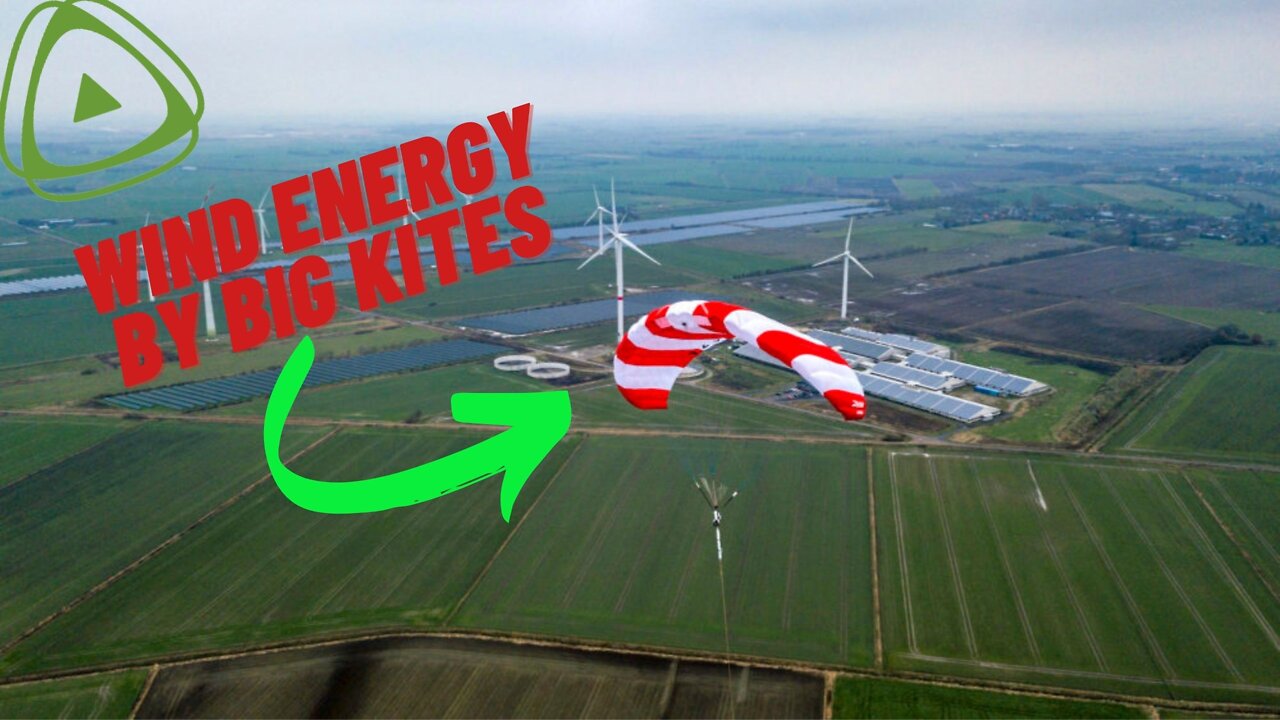Premium Only Content

🌍 #Wind #energy by big #kites🌍
🌱#Wind #energy by big #kites🌱
As the world heads towards net-zero emissions, pretty much every pathway for future electricity production foresees a big role for wind. The International Energy Association forecasts wind energy skyrocketing 11-fold by 2050, with wind and solar together accounting for 70 percent of the planet’s electricity demands.
Thanks to the expanding number of wind turbines dotting fields and adorning ridgelines worldwide, the cost of wind power has plummeted about 40 percent over the past decade.
But some experts say those massive turbines aren’t always the best solution — they can be expensive or
logistically impossible to install in remote locations or deep waters, and just can’t reach the lofty
heights where the wind blows hardest. To harvest these spots, the key may be to fly a kite. Dozens of companies and a handful of academic institutions are now investigating a plethora of airborne options.
These range from soft wings that convert the tug and pull on a kite’s line to useful energy, to complex rigid craft that carry turbines and generators on board and shuttle electricity down a tether.
Airborne systems have some key advantages, says Lorenzo Fagiano, an engineer at the Polytechnic University of Milan who is on the board of the industry association Airborne Wind Europe, founded in 2019. In some countries, suitable land for wind farms is getting slim: Wind farms typically need a whopping 71 acres to generate a megawatt, compared to 12 acres for a fossil fuel plant, and the ideal locations will eventually
run out. “The first farms are in the best spots, and the best spots are limited,” says Cristina Archer, director of the Center for Research in Wind (CReW) at the University of Delaware.
Plus, in general, the higher you go, the faster the wind. “For a two-fold increase in windspeed, that’s eight times the power,” says Fagiano. An airborne system can reach up to 800 meters high (half a mile),
far above the 200- to 300-meter tip of the tallest wind turbines. The theoretical global limit of wind power at high altitude has been estimated to be about 4.5 times greater than what could be harvested at ground level.
It’s relatively cheap and easy to bring a wing to a remote location, adds Fagiano; these systems come in a container and can be dropped off wherever there’s a road or dock. They can also be tethered to an
anchored barge in deep waters, where a traditional wind turbine cannot stand firm. Their height is adaptable, so they can be moved up or down to wherever the wind blows the hardest, which often changes
with the seasons. “It’s such a good idea,” agrees Archer. “The attraction is its simplicity in terms of materials and costs.”
“It’s not going to replace conventional wind,” adds Archer. But advocates envision wind farms hosting hundreds of kites floating on barges in deep waters far offshore, while single wings — or smaller arrays
— could unfurl to help power remote islands, temporary military installations, or mining operations in
the mountains.
These ideas have been around for decades, but the path to using kites, wings, or drones to capture wind energy has been bumpy. In 2020, for example, an airborne wind energy company acquired by Google famously folded operations after engineers couldn’t make their system work economically. But others pursuing lighter, simpler versions of the technology, like SkySails, are now going commercial. A 2021 U.S. Department of Energy report to Congress concluded that the idea has a lot of potential, with airborne systems likely capable of harvesting the same order of magnitude of energy as ground-based wind systems in the U.S. But, they add, the technology has a long way to go before it could become an important part of the nation’s energy solution.
SkySails actually started back in 2001 with a different purpose: building soft kite wings to pull ships
along at sea. The shipping industry has traditionally relied on a crude, dirty fossil fuel called bunker fuel, and the idea was that a wing could, like the sails of old, help to dramatically reduce a ship’s fuel requirements. It was a concept ahead of its time. SkySails expected oil prices to keep rising, making their product more attractive. Instead, oil prices crashed in 2009 (and again in 2014 and 2020). Now, with more
stringent requirements from the UN’s International Maritime Organization for ships to reduce emissions, other companies, including a spin-off from Airbus, are making wings to tug massive ships. But back in 2015, SkySails shifted focus to producing electricity with SkySails Power.
Their system — like several others under development — relies on a roughly 150-square-meter, parachute-like wing to ride on the wind. There are no turbines up in the air, and the tether isn’t an electric wire. Instead, the energy is generated on the ground, from the tug on the line. “The brake on the winch is generating the electricity,” says Fagiano. Software flies the kite autonomously in a figure-eight pattern to get the strongest pull possible to produce energy. The system then changes the wing’s flight pattern so it can be pulled in with minimal resistance, expending a little energy to wind it back. This pattern repeats, creating far more energy than it consumes.
It sounds simple, and the power generation system is pretty standard. But Stephan Brabeck, the chief technology officer at SkySails, says it took the team around 7 years to perfect the flying software, particularly so the wing can safely land and launch autonomously. They have now made and sold five units, Brabeck says, with the one in Mauritius the first to get up and running. They reckon that the wing will have to land some 14 times a year because of heavy rain, unsuitable winds, or thunderstorms. Occasional hurricanes, which an airborne system can
weather tucked away on ground, is what makes the island unsuitable for traditional wind turbines, says Brabeck, an aerospace engineer.
✍👉 Text✍👉: Nicola Jones 🍁Research🍁:Vitor Hugo Lizardi Leonardi
🔵🔔🔴 The channel was created to promote texts and sounds for us to think a little about life and as we can be very happy with what little we have, did you like it, leave your LIKE, your comment as soon as possible we will reply, thank you. If any writer,record label, artist or photographer has a problem with any music upload or video, please contact us and we will remove your work immediately. Thank you!
🔵🔔🔴 We strive to find the best and most enjoyable text and music for
you! We hope to make your days more beautiful with texts and music that make you think and music to relax! Text, love and music. I'm also a writer, I'm working on this project!
🔵🔔🔴 If you have any copyright issues or questions, please don't let me know. report, please take the time to contact us via email and we will respond within 48 hours 🔵🔔🔴 vitorleonardi99@gmail.com 🔵🔔🔴
#energy, #wind, #energy, #future, #wind, #kite, #world, #sustainable, #planet, #turbine, #study, #teacher, #student,
#research,
#channel, #canaldark,
#dark,#kite.
-
 55:51
55:51
The Dan Bongino Show
3 hours agoWe Are NOT Falling For This Again (Ep. 2391) - 12/19/2024
468K1.38K -
 1:03:06
1:03:06
The Rubin Report
2 hours ago‘Piers Morgan’ Goes Off the Rails as 'TYT' Host Attacks Dave with Nasty Insults
29.4K40 -
 1:47:50
1:47:50
Steven Crowder
2 hours agoLWC Christmas Special 2024 | Giving Back with Santa Crowder
101K180 -
 LIVE
LIVE
The Dana Show with Dana Loesch
44 minutes agoTRUMP SLAMS SPENDING DEAL | The Dana Show LIVE On Rumble!
659 watching -
 LIVE
LIVE
Grant Stinchfield
1 hour agoThe C.R. in One Page, Anything Longer is the Deep State Exposed
376 watching -
 23:06
23:06
The Shannon Joy Show
4 hours ago🔥🔥Live EXCLUSIVE W/ Patrick Wood On Drones, Bitcoin, Artificial Intelligence & The Technocracy🔥🔥
5.35K1 -
 2:19:25
2:19:25
Matt Kohrs
12 hours agoMarket Chaos || The MK Show
61.9K5 -
 32:38
32:38
Rethinking the Dollar
1 hour agoDebt Ceiling Drama: What Trump Wants Now | Morning Check-In
5.07K3 -
 LIVE
LIVE
LFA TV
13 hours agoDING DONG THE BILL IS DEAD! | LIVE FROM AMERICA 12.19.24 11am EST
4,932 watching -
 37:31
37:31
BonginoReport
6 hours agoShut It Down (Ep.108) - 12/19/2024
107K243